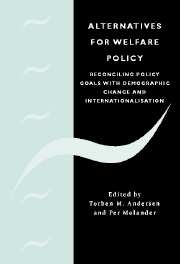Book contents
- Frontmatter
- Contents
- List of contributors
- Preface
- 1 Introduction
- 2 International integration and the welfare state
- 3 The changing age structure and the public sector
- 4 Emigration from the Scandinavian welfare states
- 5 Productivity and costs in public production of services
- 6 Use of fees in the provision of public services in OECD countries
- 7 Privatisation of social insurance with reference to Sweden
- 8 Occupational welfare
- 9 Pathways to retirement and retirement incentives in Sweden
- 10 Social insurance and redistribution
- 11 Assessing the effect of introducing welfare accounts in Sweden
- 12 Taxation in a global economy
- 13 Taxation and education investment in the tertiary sector
- 14 Debt strategies for Sweden and Europe
- 15 Policy options for reforming the welfare state
- Index
- References
1 - Introduction
Published online by Cambridge University Press: 22 September 2009
- Frontmatter
- Contents
- List of contributors
- Preface
- 1 Introduction
- 2 International integration and the welfare state
- 3 The changing age structure and the public sector
- 4 Emigration from the Scandinavian welfare states
- 5 Productivity and costs in public production of services
- 6 Use of fees in the provision of public services in OECD countries
- 7 Privatisation of social insurance with reference to Sweden
- 8 Occupational welfare
- 9 Pathways to retirement and retirement incentives in Sweden
- 10 Social insurance and redistribution
- 11 Assessing the effect of introducing welfare accounts in Sweden
- 12 Taxation in a global economy
- 13 Taxation and education investment in the tertiary sector
- 14 Debt strategies for Sweden and Europe
- 15 Policy options for reforming the welfare state
- Index
- References
Summary
The public sector and the welfare state
The growth in the relative size of the public sector is one of the most important facts of economic development during the second half of the twentieth century. Growing public sectors not only reflect a substantial improvement in material wellbeing, but are also in their own right considered to be a core element in the development of so-called welfare societies, purposely designed to affect the allocation and distribution of resources.
The growth of the public sector has always been controversial, since it raises fundamental questions concerning the balance between the private and the public spheres. The welfare states that have developed reflect political compromises between markets and public intervention, and the route taken differs between countries, depending on power balance, institutional heritage and other factors. At present these issues are increasing in importance. The welfare state faces a number of challenges, which lead many to question whether it can be maintained in its present form.
Traditionally, the main reason given for state intervention has been redistribution, and the choices made have been interpreted as reflecting a particular trade-off between equity and efficiency (Okun 1975). Even in the absence of market failures, an outcome may be considered unacceptable on political or ethical grounds. In such cases, public intervention can be justified, but it comes at a cost. In this perspective, the size of the welfare state is basically a political question.
- Type
- Chapter
- Information
- Alternatives for Welfare PolicyCoping with Internationalisation and Demographic Change, pp. 1 - 22Publisher: Cambridge University PressPrint publication year: 2003



